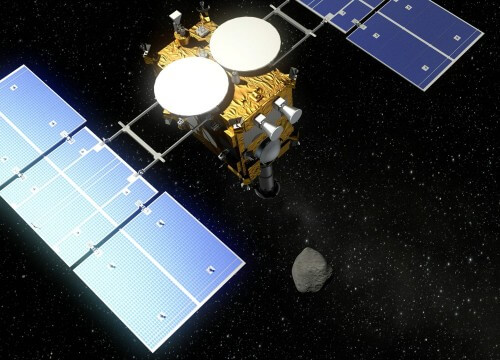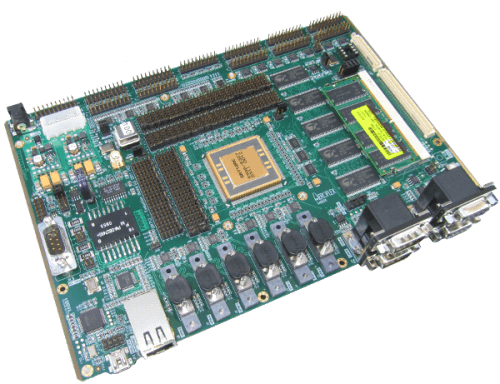In an interview with the Hidaan site, Prof. Ran Ginosar, CEO of Ramon Chips, says that the biggest challenges in developing chips for space are the radiation and maintaining a temperature at which the computer can operate. Prof. Ginosar also described the route the satellite took throughout the Israeli space industry

At the end of a three-and-a-half-year journey in space, the Japanese spacecraft Yabusa-2 is expected to arrive next Tuesday at the asteroid Ryugu. The mission includes a one and a half year survey of the asteroid, bombarding it with a large projectile, launching a jump lander with a space computer made by the Israeli company "Ramon Chips" supported by the Israeli Space Agency at the Ministry of Science, and finally returning soil samples from Riogo to Earth.
Ryugu is a near-Earth body with a diameter of about 900 meters that belongs to the group of Apollo asteroids, those asteroids whose orbit around the Sun is larger than the Earth's orbit around the Sun. Because of this, the Apollo asteroids may one day collide with Earth. Ryogo is a C-type asteroid rich in carbon, rocks and minerals, as well as organic compounds and water. According to conventional wisdom, C-type asteroids that hit the young Earth are the main source of our oceans. In addition, it is possible that these asteroids provided the building blocks for life - organic compounds. The Japanese Aerospace Exploration Agency (JAXA) hopes that the discovery of Ryugu's treasures will provide us with a better understanding of the evolution of the solar system, of the Earth, and of life itself.
Yabusa-2 contains a small cannon that will launch a copper projectile weighing two kilograms, and at a speed of two kilometers per second, with the aim of creating a crater in the asteroid. A robotic arm that will come out of the mother spacecraft will collect soil samples from the crater in order to return them to Earth. In addition, the mother spacecraft will release three small rovers that will jump on the surface of the asteroid, as well as a stationary laboratory for analyzing the composition of the soil that is capable of jumping once called Mascot - whose computer is made by the Israeli Ramon Chips.

The Israeli computer manages the lander, activates the various devices and transmits the data back to the mother spacecraft - and from there to Earth. "The feeling is amazing," says Prof. Ran Ginosar, CEO of Ramon Chips, which is supported by the Israel Space Agency at the Ministry of Science.
In an interview with the Hidan website, Prof. Ginosar describes the long way the chip has gone from the initial concept stage to the expected landing in a few months: "The chip includes two processor cores, an AMBA bus, and a number of interfaces specially adapted for use in space. The initial design was received from the Geisler company from Sweden (which works mainly for the European Space Agency) in 2006, and a number of unique interfaces for the lamp and Israeli satellites were also added to it. The Swedes performed synthesis and the Ramon Chips company, which developed radiation-resistant cell libraries on the 0.18 micron process of Tower, performed the physical design (in 2009). The production of the wafers in the tower was done in 2010. The funding for the project was provided by the Ministry of Defense (Mapat-Satellite Administration) and by the Aerospace Industry (Mabat). The components were packed (in France) in unique hermetic ceramic packages made by Kyosera (Japan). The electrical and environmental tests were conducted at the Presto company (now ATS) in Migdal Ha'emek and the radiation resistance tests were performed by MMG (Nahal Sorek), some in Israel and some at the particle accelerator in Belgium. After receiving a defense export license, the chips were transferred to Sweden in 2012, and the German Space Agency chose them for the Japanese mission, which was launched at the end of 2014. The component is used as a control computer with a (rather slow) frequency of 100 MHz.
"It's amazing to think that our computer will stay there on the asteroid, it's like a flag on the moon or on Mars, but even more challenging. Climbing Everest is nothing compared to landing on an asteroid, and who knows - maybe asteroid miners in the future will find our little box and bring it back safely."
Prof. Ginosar explains that "you have to understand that the technological challenge here is cosmic radiation. Our electronic components are bombarded by tremendous cosmic radiation, much more than satellites experience in near space, and of course there is no room for malfunctions. There is one computer, and it has to survive a three and a half year journey in deep space."
It is difficult to protect the chips from cosmic radiation by external shielding, so cells (logic gates and memories) must be built so that the radiation will not damage them. Cosmic radiation (mainly heavy ions) produces charge clouds inside the silicon that disrupt the operation of normal circuits. The circuits of Ramon Chips contain a device for grounding the unwanted charges. These circuits consume more space, more power and more delay time compared to normal logic circuits. You can also sometimes use normal commercial chips (after we checked that they are not destroyed by the radiation) but then you have to add redundancy and external protection means. Another problem in space is related to heat dissipation—operation in a vacuum requires careful thermal planning of the chip, the packaging, the card, the card basket and the entire satellite, in order to dissipate the heat by conduction (and also heat the chip, if it cools too much in space and its own power is not enough to maintain a temperature …).
Yabusa-2 will spend a year and a half around the asteroid, surveying its composition and shape, and in December 2019 the spacecraft will return to Earth on a journey that will last another year and a half. In December 2020, Yabusa-2 will release its precious cargo on Earth and the researchers will be able to analyze the findings. But many start-up companies were also interested in knowing what rare substances it contains. "The eyes of all gold, diamond and metal seekers are now on Yavusa-2", concludes Prof. Ginosar.
Ramon Chips even recently completed the development and production stages of a computer chip for space purposes that demonstrates the fastest and most powerful processing capabilities available today in the world and will be used for fast and economical data processing in satellites. The company's new chip is 500 times faster in its calculation capacity than the previous one and consumes only five times more electrical power.
